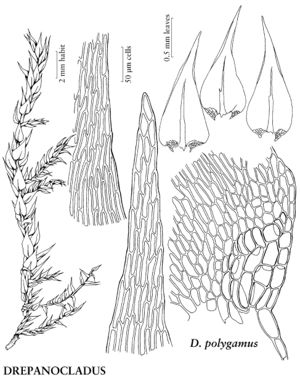Drepanocladus
Hedwigia 38(Beibl.): 6. 1899.
| Taxon | Illustrator ⠉ | |
|---|---|---|
 | Drepanocladus aduncus | Patricia M. Eckel |
 | Drepanocladus arcticus | Patricia M. Eckel |
 | Drepanocladus polygamus | Patricia M. Eckel |
| ... further results | ||
Plants small to large, green, yellow-green, yellowish, or brownish. Stems sparsely and irregularly branched to ± pinnate, ± in one plane; hyalodermis absent, central strand present; paraphyllia absent; rhizoids or rhizoid initials on stem or abaxial costa insertion, rarely forming tomentum, slightly or occasionally strongly branched, smooth; axillary hair distal cells 1–3, hyaline. Stem-leaves erect-spreading, spreading, or sometimes squarrose, straight or falcate, ovate or broadly so, ovatelanceolate, triangular, rounded-triangular, or cordate, not plicate, 0.9–6.4 × 0.4–1.6 mm; base not or hardly decurrent (narrowly decurrent in D. cardotii); margins plane, entire, slightly sinuate, or slightly denticulate, limbidia absent; apex long-acuminate to acute, acumen gradually differentiated or distinctly set off, plane or furrowed; costa double and short, single and long, or sometimes excurrent; alar cells differentiated, short-rectangular to short-linear, strongly inflated, hyaline, widest cells 17–32 µm wide, region distinct, transversely triangular or ± quadrate, reaching from margin (25–) 40–100% distance to costa at insertion; medial laminal cells linear; marginal cells 1-stratose. Sexual condition autoicous [synoicous] or dioicous. Capsule horizontal, cylindric, curved; peristome perfect; exostome margins entire or slightly dentate distally; endostome cilia 2–4, well developed, nodose or distally sometimes appendiculate. Spores 11–32 µm.
Distribution
Nearly worldwide
Discussion
Species 10 (7 in the flora).
Drepanocladus is found in more or less mineral- and nutrient-rich habitats. Differences between members of Drepanocladus and those of Campyliadelphus and Campylophyllum are discussed under 6. Campyliadelphus; characters separating Drepanocladus from 7. Campylium are mentioned under Campylium. The genus Calliergidium has been distinguished from Drepanocladus by its acute to obtuse leaf apices. However, the type of this genus, C. bakeri (Renauld) Grout, is a synonym of Drepanocladus aduncus, and Calliergidium is thus a synonym of Drepanocladus. Drepanocladus is widely distributed in the Holarctic region, in the temperate regions of the southern hemisphere, and in higher mountains in tropical and subtropical areas.
In the following key, as well as in the species descriptions, the ratios between the laminal cell and leaf sizes should be based on measurements in 8–10 adjacent stem leaves. The total size ranges should be searched for, and the median values of these should be used for the calculations of the ratios.
The name Drepanocladus sendtneri (Schimper ex H. Müller) Warnstorf has been used in the American literature, but this species is apparently restricted to Eurasia and Africa. It is distinguished from D. sordidus by a different ratio of medial laminal cell length (/um) to leaf length (mm), 17.9–24.4 (23.3–36.5 in D. sordidus).
Selected References
None.
Lower Taxa
Key
| 1 | Sexual condition autoicous (unknown in D. cardotii); leaves spreading to squarrose, straight or falcate; acumina furrowed | > 2 |
| 1 | Sexual condition dioicous; leaves falcate-secund or rarely straight; acumina plane or furrowed | > 4 |
| 2 | Plants small; stem leaves 1-1.4 mm; bases narrowly decurrent 1/4 -3/4 distance to leaf below. | Drepanocladus cardotii |
| 2 | Plants medium-sized to large; stem leaves usually 1.7-3.6 mm; bases not or hardly decurrent | > 3 |
| 3 | Stem leaf insertions slightly curved; bases erectopatent to ± spreading; acumina not or gradually differentiated, furrowed; costae single or 2-fid to 1/2 -2/3 leaf length, or double and ending before mid leaf; leaves 0.6-1(-1.1) mm wide; temperate, Arctic. | Drepanocladus polygamus |
| 3 | Stem leaf insertions deeply U-shaped; bases erect, subclasping; acumina usually sharply differentiated, furrowed or strongly furrowed; costae double and short, very rarely single and ending well before mid leaf; leaves 0.6-1.5 mm wide; Arctic. | Drepanocladus arcticus |
| 4 | Stem leaf costae excurrent or longly so, rarely ending few cells before apex. | Drepanocladus longifolius |
| 4 | Stem leaf costae ending well before apex | > 5 |
| 5 | Ratio of medial laminal cell length (µm) to leaf length (mm) 37.6-45.6; stem leaves1.1-2.1 × 0.5-0.7 mm; alar regions quadrate, transversely short-rectangular, or transversely triangular, not reaching costa; Arctic. | Drepanocladus latinervis |
| 5 | Ratio of medial laminal cell length (µm) to leaf length (mm) 17.9-36.5(-38.2); stem leaves 0.9-5.2 × 0.4-1.6 mm; alar regions either transversely triangular and reaching costa or almost so, or quadrate or transversely short-triangular and not reaching costa; widespread, sometimes Arctic | > 6 |
| 6 | Alar regions transversely triangular, reaching costa or almost so; stem leaves variously straight or falcate-secund, the latter especially in small plants growing under relatively dry conditions. | Drepanocladus aduncus |
| 6 | Alar regions quadrate or transversely short-triangular, not reaching costa; stem leaves strongly falcate-secund, rarely weakly so, the latter especially in submerged plants. | Drepanocladus sordidus |
"narrower" is not a number.